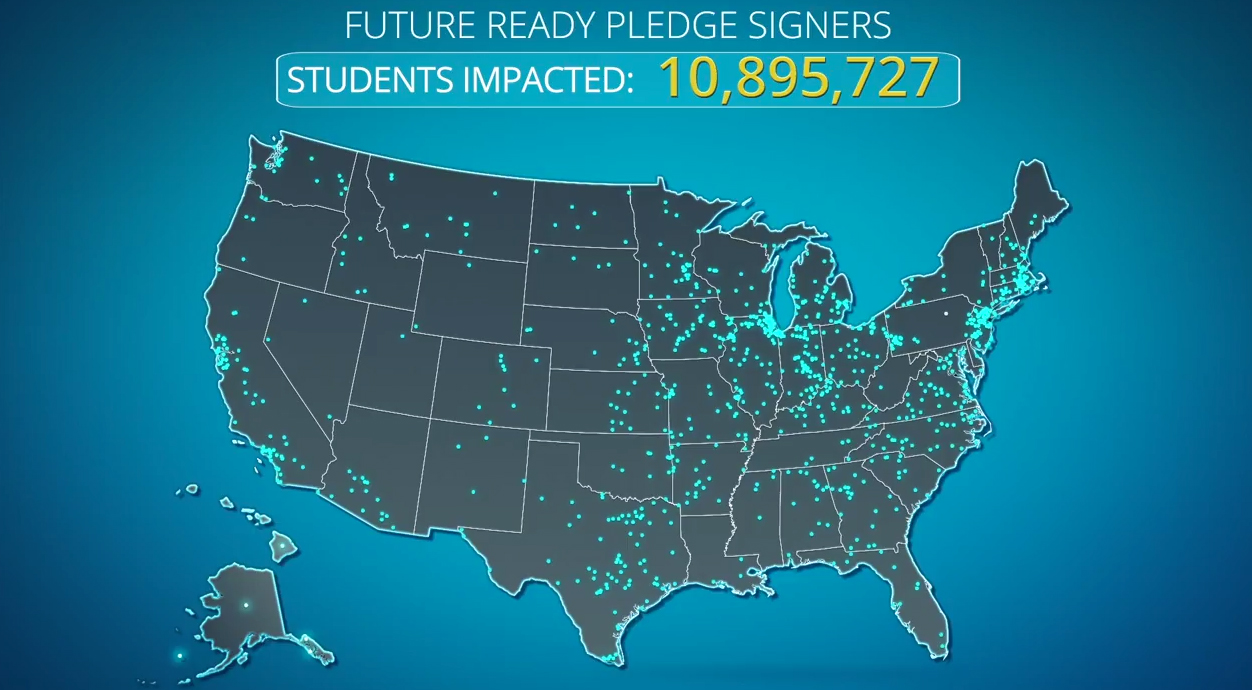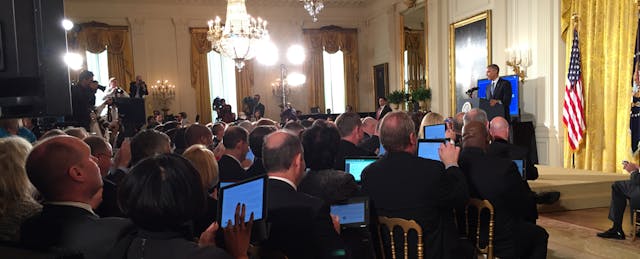President Barack Obama opened his remarks at the “ConnectED to the Future” gathering with an offer to write any superintendent a note to excuse their absence from school since they were “playing hookie” to visit the White House.
Rubbing shoulders with President Obama and 18 of his senior staff, including US Secretary Arne Duncan, doesn’t happen every day. In fact, rarely, according to Richard Culatta, executive director of the Office of Education Technology, do this many senior staff participate in any White House event.
Yet, on Nov. 19, the 110 superintendents who gathered with Obama to sign a pledge to make their districts “Future Ready” had the honor of this rare, focused attention.
"Every child deserves a shot at a world-class education," Obama declared. "That's the promise we make as a nation." To deliver on that promise, "we need to yank our schools into the 21st century when it comes to technology, and provide the training and tools our teachers need."
The President cited his ConnectED Initiative, which debuted last year, as an important step. At that point, he convinced 10 technology companies to make largely in-kind donations worth up to $2 billion to support technology in schools. He also lauded edX for making verified certificates for students taking AP courses, and for teachers who complete professional development (PD) courses, available for free. Similarly, Coursera is making many of their PD courses, and certifications for teachers who successfully complete them, available for free, at least for the next year.
Obama also lauded the Federal Communications Commission's moves to bolster funding for broadband access in the schools. This week FCC chairman Tom Wheeler proposed making additional funds--up to $1.5 billion--available to schools.
By asking districts and other organizations to pledge their support the "Future Ready" program, the President hopes to use the power of persuasion to strengthen efforts to use technology to support learning in schools. An estimated 1,200 superintendents from around the US have already signed the pledge, which had been in circulation for several weeks leading up to this event. (The pledge is hosted on this Future Ready website.)
All the signees will be eligible to attend one of the dozen regional summits that the Future Ready Schools initiative is planning to hold around the country in 2015. Almost 30 organizations have also agreed to help support the effort. (Editor's note: EdSurge is among them.)
And with help from the Alliance for Excellent Education, a DC-based nonprofit that is partnering with the US Department of Education on this initiative, the program is also offering a "Future Ready District Assessment" that districts can use to diagnose their digital readiness and frame their plan to improve student learning. The department will also publish a Future Ready Technology Infrastructure Guide to provide technical assistance with specific examples to help schools improve their infrastructure.
After Obama, the afternoon continued to be a parade of the who’s who at the White House.

How Do We Measure Future Ready Success?
Outgoing Education Deputy Secretary, Jim Shelton, moderated a panel of superintendents, principals and teachers around the question of measuring what “Future Ready” success might look like, and what benchmarks can be used to measure progress. The conversation also dived into specifics around how schools can interact with edtech entrepreneurs--and measure results.
When choosing tools from early-stage companies, Ravi Gupta, founder and director of Nashville Public Charter Schools, “places more emphasis on the team rather than the specific tool.” For example, he recognized that “Khan Academy isn’t quite there yet,” but “believes in their vision and theory of research.”
Suzanne Lacey, superintendent from Talladega County, AL, not only includes teachers in conversations about piloting tools, but also brings students into the dialogue because “they ask questions not raised previously.” She also looks closely at what professional development is offered to support implementation.
Pam Moran, Superintendent at Albemarle County Public Schools in Virginia, applies a rigorous screening process before trying new tools. Her team looks for “tech products that will help accomplish a higher level of work” and that will integrate into the classroom, rather than running parallel. Evidence of student progress also weighs in on Moran’s decisions to try something new.
Jimmy Casas, principal of Bettendorf High School in Iowa, said he never looks to new tools as silver bullets: “Great teaching is the equalizer, not a particular device.” His vision of Future Ready success: “Anyone can walk into a school or classroom and they all have the tools they need to do the work they need to do at a high level. That’s success.”
Professional Development
Many speakers highlighted the need to build educator capacity, one of the key tenets of the ConnectED initiative. Rafranz Davis, an instructional tech specialist at Arlington Independent School District in Texas, emphasized the importance of community bonds in allowing her district to shift its teaching and learning model. Change, she argued, needs to go beyond simply adding technology; it must also include a shift in learning.
“At Arlington we’ve seen classrooms transform from desks in rows to real-world, explorative learning where kids are empowered to be creators, explorers, scientists, engineers and even coders,” she explained.
In order to create this kind of learning environment, Davis argued that we can’t forget the educators: “Future Ready teaching is about putting technology in the hands of all learners--to empower teachers and students.” According to her, providing ongoing, personalized professional development is key to success because Future Ready schools are about “multiple paths of growth” for teachers as well as students.

Superintendents Spend Time with US Secretary Arne Duncan
Duncan and Culatta rounded out the day by taking suggestions and fielding questions from the gathered superintendents at the final session of the day. Here’s what the superintendents want (in bold), followed by Duncan’s responses:
- More flexibility in how they spend Title I, Title 2 and other federal funds: Duncan explained that schools “push us hard on this issue” because they want to be as flexible as possible. “Districts often believe there are more restrictions than really exist,” so he advocated checking with their offices for final determinations.
- Revision of seat time requirements: The department is supportive and working on it.
- Updating teacher preparation programs: Stay tuned, said Duncan. The department will be posting a draft plan for public comment that addresses this issue.
- More connectivity for students outside the classroom: Duncan said some districts have used e-Rate funds to support home access. He mentioned one example where a district created Wi-fi hotspots on school buses which are left parked around the neighborhoods to provide access for whole communities.
- District participation even when a state isn’t on board: Duncan insisted that while the department is “getting better at managing relationships with 50 states...Managing relationships with 16,000 districts is more difficult.” Still, the Dept. of Education has made some avenues here, such as granting waivers to eight districts in California and establishing district grants.
- Assessments that measure important 21st century skills: Duncan argued that the two consortia, while not perfect, will offer better assessments than anything superintendents now have. He recognizes the need to continue looking at how to measure soft skills such as determination and creative thinking.
- Standardized teacher accreditation: This point received an ovation from the other superintendents but wasn’t included in Duncan’s final comments.
This rare gathering of decision-makers on both the district and federal levels to discuss next steps for driving digital learning forward was truly a landmark moment. Bob Wise, former governor and current president at the Alliance for Excellent Education, summed up his optimism for Future Ready: “Though the government may be known for gridlock, digital learning is moving forward at a gigabyte speed.”


